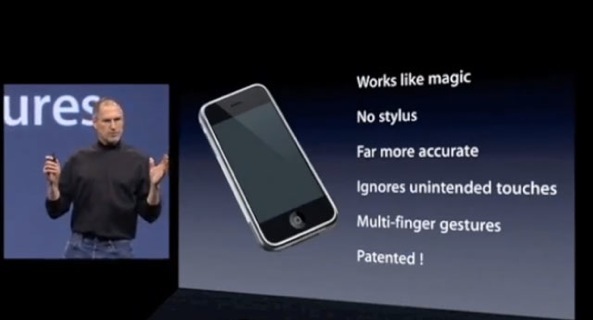“Boy, have we patented it!”, quipped Steve Jobs in wrapping up the segment of his January 2007 MacWorld Expo presentation dealing with the iPhone’s multi-touch user interface.
Months later, Jobs through the combination of sheer willpower, yelling and F-bombs would impose restrictions on early Android releases.
The goal was to prevent Google’s smartphone software from employing multitouch gestures on mobile devices that Apple had been researching for years. The strategy eventually failed, prompting Apple to launch proxy battles against Android backers such as HTC, Samsung and Motorola over prized iPhone inventions.
One guy was unimpressed, though: a California inventor has been claiming for years now that he holds a patent related to an essential iPhone feature. He’s not afraid to take the consumer electronics powerhouse to court in order to prove the infringement and seek a five percent cut of Apple’s US sales, Bloomberg reported Tuesday…
The Bloomberg article explains:
Apple Inc., the world’s most valuable technology company, faces a trial over claims by a California inventor that a patent he holds covers key features of the iPhone. Apple maintains the NetAirus Technologies LLC patent is invalid because the technology was known long before the company filed its patent.
NetAirus’s owner Richard L. Ditzik invented the 1997 patent application for a handheld device that combines computer and wireless-communications functions over both local and wide-area network.
He filed a lawsuit against Apple three and a half years ago, claiming Apple ripped off his invention which allows devices such as the iPhone to automatically switch between a Wi-Fi and a cellular network connection.
Apple argues its own Newton message pad preceded Richard’s invention.
The technology at issue was so well known at the time NetAirus filed its patent, that independent patent watchdogs have made NetAirus’s patent a poster child in the movement to limit the proliferation of facially invalid patents.
The case is limited to pre-iPhone 4s devices as the judge denied NetAirus’s motion to include later iPhone and iPad hardware in its complaint. Should Ditzik prevail, Apple will have to pay some damages.
If you ask Ditzik, a reasonable royalty rate would be something between three to five percent of Apple’s U.S. sales. Fortunately, the Judge has dismissed his proposal as an “improper expert opinion offered by a lay person”.
Bloomberg adds:
In May, Apple won a ruling that NetAirus can’t seek damages for alleged infringement that occurred before Oct. 8, 2012, when the U.S. Patent and Trademark Office issued a reexamination certificate that the judge agreed “substantially” changed the patent’s claims. The ruling narrows the potential damages to sales of iPhone 4 models after that date.
Speaking of inventors, here’s Jobs presenting the original iPhone’s patented multi-touch user interface.
Too bad Google’s former CEO Eric Schmidt, who at the time had a seat on Apple’s board, betrayed Jobs with Android, which marked the start of the Great Smartphone Patent Wars.
